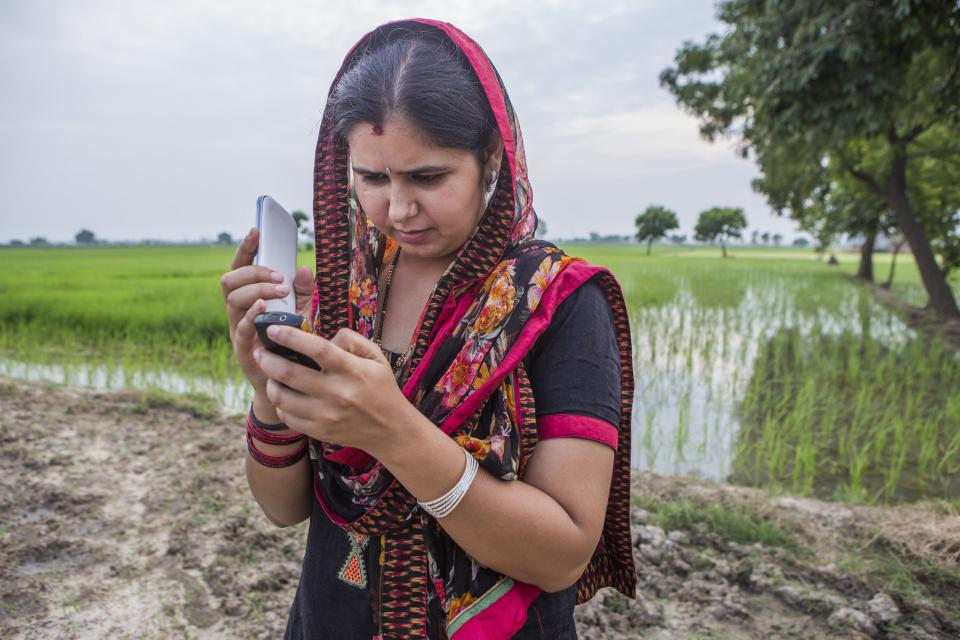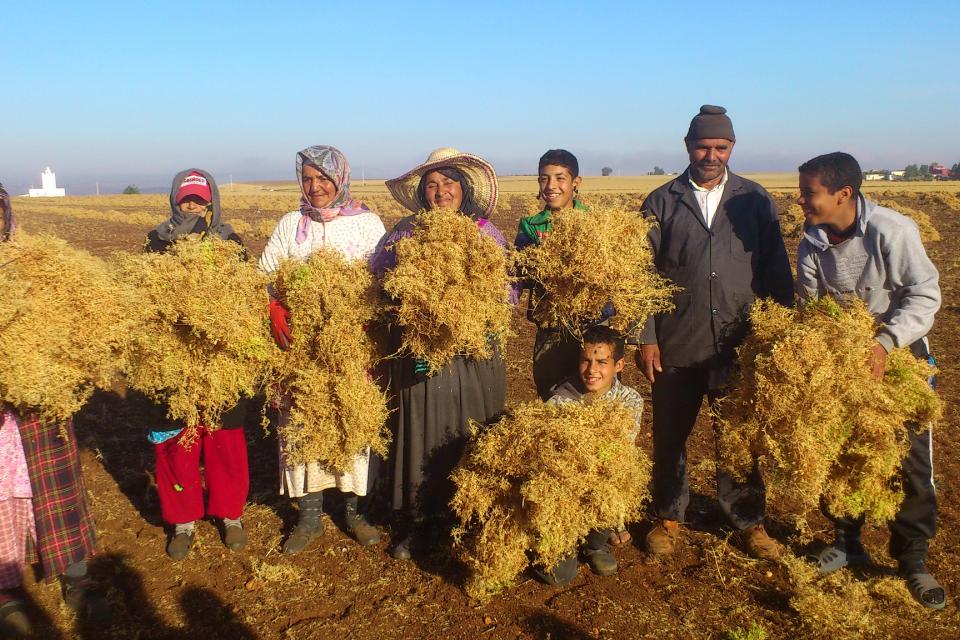How can migration-induced feminization of agriculture empower women in the dry areas?
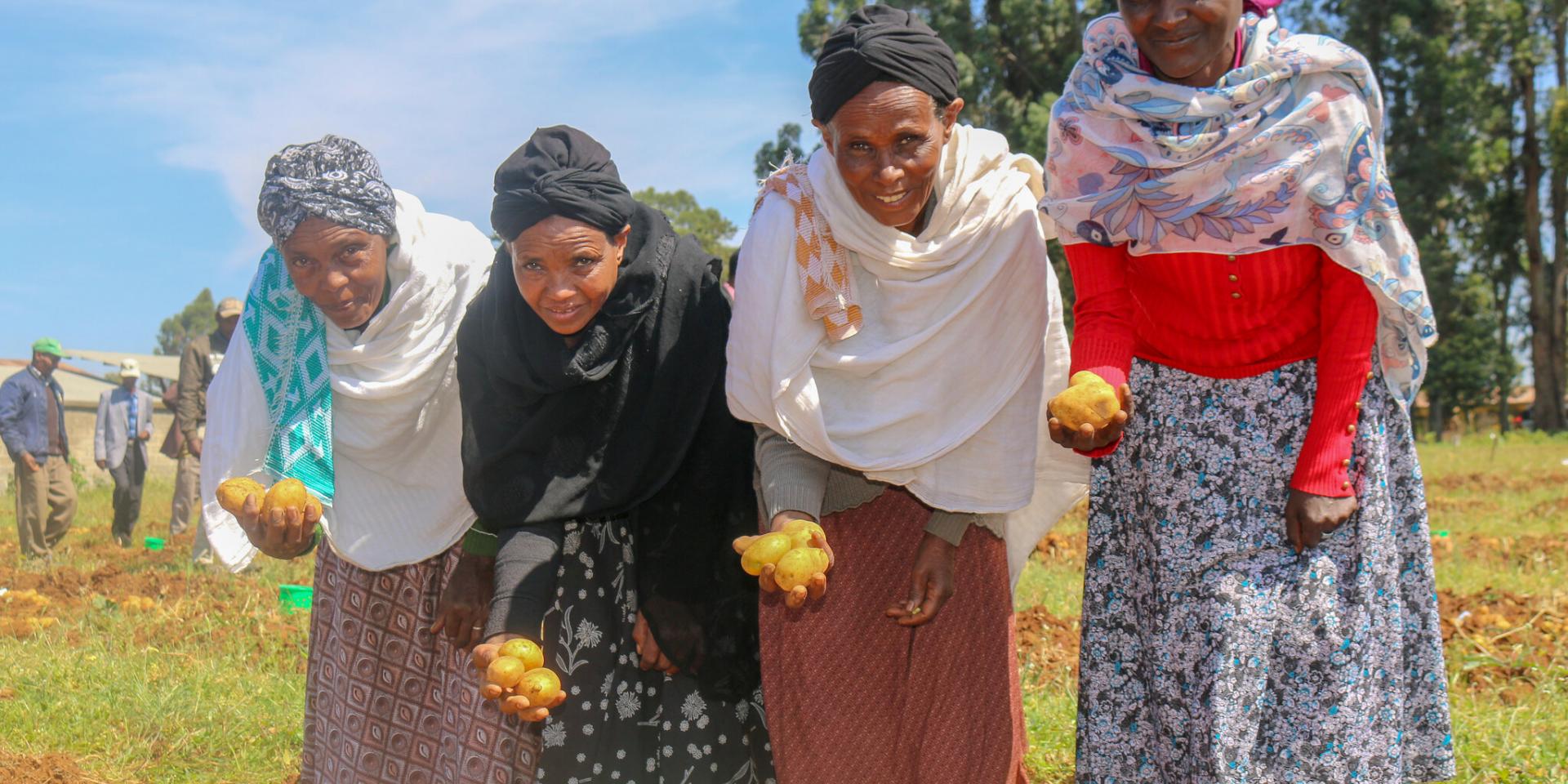 Photo: CIP
Photo: CIP
Key messages:
- Increasing migration of people out of the world’s dryland areas affects women’s roles in agriculture and related activities, which in turn affects their productivity and gender equity.
- Women are performing more farm labor in agrarian societies due to the increasing outmigration of men, and this feminization of agricultural labor and management seems to have more drawbacks than benefits for women.
- Opportunities exist for social and economic policy interventions to leverage the increasing participation of women in dryland agriculture to improve women's livelihoods.
Drylands are home for most of the world’s people but are degraded, so many men migrate elsewhere
Two-thirds of the world’s people live in deserts and dry areas, which together are known as drylands. Agriculture in these communities is significantly changing because of irrigation, extreme effects of climate change, globalization and decreasing food production.
People often migrate away from their communities because farming resources are degraded—and this affects who works, what paid or unpaid work they do, how agriculture is managed, who makes farming decisions and what choices they make.
Not only do the difficulties “push” people to migrate away, but better transport and paid work elsewhere provide a “pull” factor as well.
This process, called outmigration, is much more common for men and has led to a strong feminization of agriculture in the drylands. In a recent systematic review of literature, we examined the effects of male outmigration on the feminization of agrarian dryland economies.
Feminization of agriculture makes women more vulnerable to marginalization
Feminization of agriculture and feminization of agricultural labor is variously defined as women’s increasing share in on-farm drudge work, decision-making and resource management.
However, women are more likely to take on an increasing share of labor than an increasing share of managerial work.
Critically for increased productivity and gender equity, feminization of agriculture in the dry areas has been shown to make rural women more vulnerable to economic, social and cultural marginalization.
This comes about because increasing women’s agrarian labor reduces their incomes and worsens the economic state of their households. As well, when men return, women are often disadvantaged in the process of renegotiating labor roles.
However, non-migrant women are not sufficiently recognized as an at-risk group that requires policy interventions. There is an urgent need for structural changes that can minimize the negatives and leverage the positives of increasing feminization of agriculture.
The increased feminization of farming has been associated with low agricultural productivity, low earnings, poor job security and growing food insecurity. This raises concerns about the sustainability of smallholder agriculture in dryland societies.
Patriarchal customs affect nearly every aspect of dryland agriculture
The reach of gender relations and norms affect nearly every process and role in dryland communities. The processes are rooted in sociocultural customs, are patriarchally oriented, and often result in or exacerbate gender inequalities. There are strong gender norms and expectations within families and communities. Our literature review indicates that:
- Feminization of agriculture more often involves women from poorer households who own little or no land.
- Women generally perform manual, time-intensive, lower paying work such as fruit, vegetable and cotton harvesting, drying produce and transplanting rice. They also often have less job security.
- Women and men adapt differently to climate change: women are more likely to focus on adaptations that feed their families rather than cash cropping.
- Local formal or informal institutions such as extension services or farmers’ cooperatives often exclude women from participating. Women have limited credit and land rights compared to men.
- There are fewer opportunities for women off-farm than for men, and women are more likely to accept very low-paying off-farm jobs.
Some benefits and many drawbacks exist for women’s increased role in farming
Feminization of farming by women can have benefits:
- It can support women’s empowerment and provide women with more autonomy, as more women become primary decision-makers and have greater access to income accrued from the farms.
- Women may benefit from extra flexibility in their schedules; the ability to combine family and economic work; taking part in more social, economic and political events; and having a better chance that land is registered in their name.
However, there appear to be more drawbacks than benefits:
- Even if migration decisions are made as a family, outcomes favor men. Women must take up the missing labor, even if men work in the same community but off-farm.
- Women end up with less time for leisure and socializing, and face more socioeconomic, physical health, mental health and cultural challenges.
- Women who take up traditional male roles to sustain the family after men migrate are often frowned on in communities because they have transgressed sociocultural norms.
- When men return to work on-farm, there may be significant conflict or stress in households and communities as roles are renegotiated or returned to.
Some researchers believe that feminization of agriculture without family, societal and state support could lead to greater feminization of poverty. As well, some scholars question whether the benefits of agricultural feminization are actually the result of the benefits of male outmigration.
Policy interventions could maximize the benefits of feminizing agriculture in the drylands
Researchers and practitioners must look more closely at the growing trend of the feminization of agriculture in dryland areas. This would help to develop policies to address rural women’s growing marginalization.
Policy shifts could focus on areas such as:
- designing, mainstreaming, monitoring and evaluating gender-sensitive interventions in dryland areas
- designing interventions that mitigate the effects of climate change
- training people on how to efficiently use scarce water resources
- diversifying people’s employment opportunities
- helping dryland people intensify agriculture where they have decent rainfall
- helping subsistence communities build resilient and sustainable livelihoods
- maximizing economic benefits to those who do migrate so they can send money home
- adequately paying women and men in agriculture
- validating women in paid and unpaid farming roles, whether “masculine” or “feminine”
- making farming community services more women-friendly
- protecting people in lean seasons
- training women in higher paying agricultural tasks
- making sure women’s empowerment does not rely on men’s outmigration, such as by implementing gender-transformative approaches.
Suggested citation:
Najjar, D. 2021. How can migration-induced feminization of agriculture empower women in the dry areas? CGIAR GENDER PLATFORM Evidence Explainer. Nairobi, Kenya: CGIAR GENDER Platform. https://hdl.handle.net/10568/114808.
References
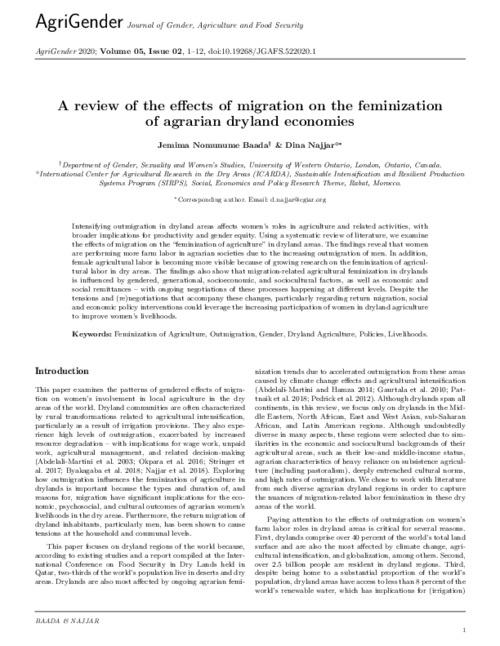
A review of the effects of migration on the feminization of agrarian dryland economies
Towards a feminization of agricultural labour in Northwest Syria
Malika Abdelali-Martini, Patricia Goldey, Gwyn Jones & Elizabeth Bailey (2003) Towards a Feminization of Agricultural Labour in Northwest Syria, The Journal of Peasant Studies, 30:2, 71-94, DOI: 10.1080/03066150412331311139
Does the feminisation of agricultural labour empower women? Insights from female labour contractors and workers in northwest Syria
Malika Abdelali‐Martini, Jennie Dey de Pryck, Does the Feminisation of Agricultural Labour Empower Women? Insights from Female Labour Contractors and Workers in Northwest Syria, Journal of International Development, 10.1002/jid.3007, 27, 7, (898-916), (2014). Wiley Online Library
How do migration remittances affect rural livelihoods in drylands?
Abdelali-Martini, M. and R. Hamza. 2014. “How do migration remittances affect rural livelihoods in drylands?” Journal of International Development 26 (4), 454–70
https://doi.org/10.1002/jid.2896
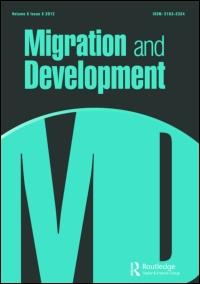
Human mobility in response to rainfall variability: opportunities for migration as a successful adaptation strategy in eight case studies
Tamer Afifi, Andrea Milan, Benjamin Etzold, Benjamin Schraven, Christina Rademacher-Schulz, Patrick Sakdapolrak, Alexander Reif, Kees van der Geest & Koko Warner (2016) Human mobility in response to rainfall variability: opportunities for migration as a successful adaptation strategy in eight case studies, Migration and Development, 5:2, 254-274, DOI: 10.1080/21632324.2015.1022974
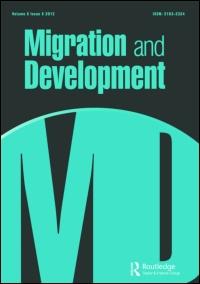
What we were running from is what we’re facing again’: examining the paradox of migration as a livelihood improvement strategy among migrant women farmers in the Brong-Ahafo Region of Ghana
Jemima Nomunume Baada, Bipasha Baruah & Isaac Luginaah (2019) ‘What we were running from is what we’re facing again’: examining the paradox of migration as a livelihood improvement strategy among migrant women farmers in the Brong-Ahafo Region of Ghana, Migration and Development, 8:3, 448-471, DOI: 10.1080/21632324.2019.1573564
The role of rural-urban migration in the structural transformation of Sub-Saharan Africa.
Women's Contributions to Climate Change Adaptation in Egypt's Mubarak Resettlement Scheme through Cactus Cultivation and Adjusted Irrigation
Women, Decent Work and Empowerment in Rural Egypt
Women, work, and wage equity in agricultural labour in Saiss, Morocco
Women, irrigation and social norms in Egypt:
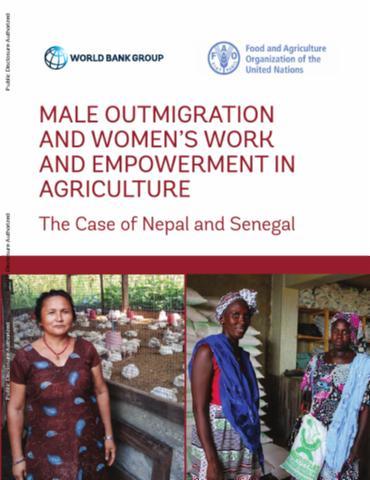
Male outmigration and women’s work and empowerment in agriculture: the case of Nepal and Senegal
World Bank Group; Food and Agriculture Organization of the United Nations. 2018. Male Outmigration and Women's Work and Empowerment in Agriculture : The Case of Nepal and Senegal. World Bank, Washington, DC. © World Bank. https://openknowledge.worldbank.org/handle/10986/30066 License: CC BY 3.0 IGO.

